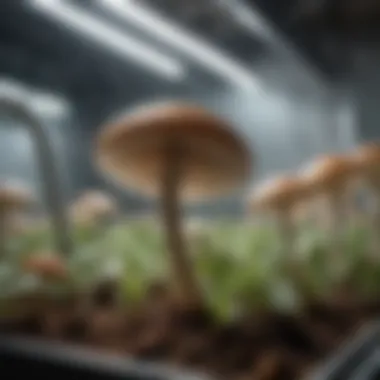Mastering Humidity Control in Mushroom Grow Tents


Intro
Maintaining optimal humidity levels is crucial in mushroom cultivation. This factor plays a significant role in the growth and development of various mushroom species. Failure to control moisture levels can lead to issues such as poor yields, contamination, and compromised quality. This article explores the essential contributions of humidifiers in creating a conducive environment within grow tents, making it an invaluable resource for both novice and experienced cultivators.
Key Concepts and Terminology
Basic Definitions
Humidity refers to the amount of water vapor present in the air. In mushroom cultivation, it is typically measured as relative humidity (RH), which indicates the current water vapor level compared to the maximum possible at that temperature.
For different mushroom species, specific humidity ranges are necessary. For instance, oyster mushrooms thrive at an RH of 85-95%, while shiitake mushrooms prefer around 75-85%.
Historical Context
The understanding of humidity's role in plant cultivation has evolved over time. Traditionally, farmers relied on natural conditions for growing mushrooms. As cultivation practices advanced, the introduction of controlled environments allowed for better management of humidity. Now, with the help of technological innovations, humidifiers have become integral tools in optimizing the growth conditions for mushrooms.
Recent Innovations and Trends
Technological Advancements
Modern humidifiers utilize advanced technology to regulate humidity levels more accurately. Digital hygrometers and automated systems can adjust moisture levels based on real-time readings. Some humidifiers even offer ultrasonic features, which produce fine mist and provide more even humidity distribution within grow tents.
Sustainable Practices
With the growing awareness of environmental issues, many cultivators are turning to sustainable practices. Energy-efficient humidifiers save power and reduce overall carbon footprints. Additionally, using rainwater or filtered water in humidifiers can minimize the risk of contaminants that tap water might contain.
Practical Applications and Techniques
Step-by-step Guides
To successfully optimize humidity in mushroom grow tents, consider the following guidelines:
- Identify Humidity Needs: Research the specific humidity requirements for the mushroom species you are growing.
- Choose the Right Humidifier: Depending on the size of your grow tent, select a humidifier that can maintain consistent moisture levels. Options include ultrasonic, evaporative, and steam humidifiers.
- Monitor Humidity Levels: Use a reliable hygrometer to keep track of humidity levels in your grow tent. Adjust the humidifier settings as needed.
- Regular Maintenance: Clean the humidifier regularly to prevent mold and bacteria growth. Regular maintenance ensures longevity and effectiveness of the humidifier.
Case Studies
Numerous successful mushroom cultivators have shared their experiences with humidifiers. For example, a commercial oyster mushroom farm in the Pacific Northwest reported a 30% increase in yield after implementing advanced humidification techniques. By automating humidity control, the farm achieved a consistent moisture level, significantly reducing crop loss due to contamination.
"The difference in mushroom quality before and after adjusting our humidity control is remarkable. Our customers notice the improvement, and so do we."
The End
Prolusion to Mushroom Growth Environments
Understanding the growth environment for mushrooms is essential for successful cultivation. Proper humidity levels play a crucial role in the development of mushrooms, affecting their growth rate, yield, and overall health. Consequently, growers must pay attention to creating and maintaining these controlled environments to ensure optimal conditions.
The relationship between humidity and mushroom growth is intricate. Mushrooms require specific moisture levels to thrive, as too little or too much humidity can hinder their development. A controlled environment mitigates these risks, allowing cultivators to create an ideal setting based on the needs of the mushroom species being grown.
In grow tents, which provide an enclosed space, managing humidity becomes easier compared to open-air systems. With the help of humidifiers, growers can consistently maintain moisture levels that are conducive to mushroom health. This method not only simplifies the cultivation process but also enhances the overall success of mushroom farming.
Understanding the Importance of Controlled Environments
The significance of controlled environments in mushroom cultivation cannot be overstated. These environments allow cultivators to recreate conditions mimicking the natural habitat of mushrooms while also minimizing external factors that might negatively impact their growth.
Humidity control is one of the essential elements of these environments. Humidity influences not only the rate of growth but also the flavor and texture of the final product. When humidity is managed effectively, it can prevent diseases and pest infestations, which are common threats in mushroom cultivation.
"Controlled environments help in achieving consistent results in mushroom growing, which is vital for commercial growers."
Moreover, a stable environment supports reliable harvesting cycles, enabling cultivators to plan better for production. This predictability is especially important for those looking to supply markets regularly. Therefore, investing time and resources into creating a controlled setting yields considerable benefits.


Mushroom Species and Their Humidity Needs
Different mushroom species have varying humidity requirements. It is essential to understand these differences to optimize cultivation practices.
Common species such as Agaricus bisporus (button mushrooms) thrive in humidity levels around 60-70%. In contrast, Pleurotus ostreatus (oyster mushrooms) may require higher levels, between 80-90%. Recognizing these specific needs allows growers to tailor their humidity control methods accordingly.
Additionally, certain life stages of mushrooms may have differing humidity needs. For instance, the fruiting stage often requires higher moisture than the colonization stage. Thus, adjusting humidity levels throughout the growth cycle becomes another critical aspect of successful mushroom cultivation. By doing so, growers not only maximize yield but also enhance the quality of the mushrooms produced.
The Role of Humidity in Mushroom Cultivation
Humidity is a critical factor in mushroom cultivation. It significantly influences the growth, yield, and quality of different mushroom species. Maintaining optimal humidity levels creates an ideal microenvironment for mushrooms, which are sensitive to changes in moisture. Therefore, understanding and managing humidity must be a priority for any serious mushroom cultivator.
Humidity affects various biological processes within mushrooms. For example, the development of fruiting bodies is intricately linked to humidity levels. Higher humidity can promote larger and denser crops, while low humidity can stunt growth, leading to smaller yields.
This balance is especially important during different stages of mushroom growth. Some stages require higher humidity to trigger pinning and fruiting, while others may need lower humidity to prevent rot or contamination. Without careful management of humidity, cultivators may face challenges, such as diminished yields or increased susceptibility to diseases.
Proper humidity control is a cornerstone of successful mushroom cultivation, impacting both quantity and quality of harvests.
Effects of Low Humidity on Mushroom Development
Low humidity can have detrimental effects on mushroom growth. When moisture levels drop, mushrooms tend to become dehydrated. This dehydration not only affects their size but also their overall health. The manifestation of symptoms such as shriveled fruit bodies can be very common in conditions of insufficient moisture. Development can slow considerably when humidity dips below the ideal range.
In addition to physical changes in the mushrooms, low humidity can also restrict mycelial growth, the vegetative part of the fungus. The mycelium requires moisture for nutrient absorption and colonization of the substrate. Insufficient moisture can lead to uneven growth and increased competition from other fungi or bacteria.
Some specific impacts of low humidity include:
- Small-sized fruit bodies
- Poor texture and flavor
- Delayed fruiting
- Increased risk of diseases due to weakened plants
The Risks Associated with High Humidity
While humidity is essential for mushroom growth, excessive humidity comes with its own set of risks. High humidity creates an environment favorable for the development of mold and other pathogens. This can lead to contamination, which can wipe out entire crops. Recognizing this potential threat is crucial for any cultivator.
Other problems associated with high humidity include:
- Increased condensation, which can lead to water-logging and stunted growth.
- Potential for increased pest infestations due to favorable conditions.
- Difficulty in managing air circulation, which is necessary to maintain healthy growing conditions.
To manage high humidity levels, cultivators should consider implementing adequate ventilation systems in conjunction with their humidifiers. Monitoring humidity levels closely is crucial to strike a balance that prevents either extreme. Using tools like hygrometers can aid in this monitoring.
Choosing the Right Humidifier for Grow Tents
Selecting an appropriate humidifier is a critical step in optimizing the cultivation of mushrooms within grow tents. The right humidifier maintains the ideal humidity levels required for the specific species of mushrooms being grown. Without this, growers risk facing significant challenges such as poor yields, stunted growth, or even crop failure.
When it comes to humidifiers, different models serve unique purposes. Understanding these differences helps in making an informed choice. Furthermore, a well-selected humidifier can also reduce energy costs and improve moisture distribution within the tent.
Types of Humidifiers Available
There are several types of humidifiers available, each with its advantages and disadvantages. Here’s a brief overview:
- Ultrasonic Humidifiers: These create mist through ultrasonic vibrations. They are quiet, energy efficient, and can easily adjust humidity levels. They work excellently for smaller grow tents but often need regular cleaning due to mineral buildup.
- Evaporative Humidifiers: They use a fan to blow air through wet pads, which then evaporates water to add humidity to the air. These units tend to self-regulate but can require more maintenance and may not be ideal for very high humidity needs.
- Steam Vaporizers: These boil water and release steam into the air. They provide a quick humidity boost and can work well in larger tents. However, they consume more energy and can heat the air in the tent, which might not always be desirable.
- Cool Mist Humidifiers: They combine features from both steam vaporizers and ultrasonic units. They can deliver large volumes of humidity without heating. However, they can also make the environment too cold if not monitored correctly.
Choosing the right type of humidifier will be vital in ensuring that the specific humidity needs of your mushrooms are met.
Factors to Consider When Selecting a Humidifier
Several factors should be taken into account before choosing a humidifier:
- Grow Tent Size: The area of your tent largely determines the type of humidifier you will need. Larger tents may require more powerful units or multiple humidifiers to ensure uniform humidity.
- Mushroom Species: Different mushrooms have varying humidity requirements. For instance, oyster mushrooms thrive at higher humidity levels, while shiitake mushrooms prefer slightly lower moisture.
- Water Source: Consider how you will provide water to the humidifier. Some units have built-in tanks, while others can connect directly to a water line. This can influence maintenance and refilling needs.
- Maintenance Requirements: Humidifiers need regular cleaning to prevent mold growth and mineral deposits. It's crucial to choose a model that fits your willingness and ability to maintain it.
- Energy Efficiency: An energy-efficient model can reduce costs in the long run. Look for units with good energy ratings to minimize the environmental impact and keep operational costs low.
Overall, investing time in understanding the types of humidifiers and their operational needs ensures efficient humidity management in your grow tents. This not only fosters healthy mushroom growth but can also significantly enhance yields.


Setting Up Your Humidifier in the Grow Tent
Setting up a humidifier in your mushroom grow tent is crucial for successful cultivation. Humidity control directly impacts growth, fruiting, and yield quality. Properly setting up your humidifier can create a stable environment for your mushrooms, minimizing stress and promoting healthy development. This section outlines practical steps, benefits, and key considerations for humidifier installation.
Placement Considerations
The placement of your humidifier is vital in maintaining consistent humidity levels. Here are important factors to consider:
- Airflow Efficiency: Position the humidifier where air circulation is optimal. This allows moisture to distribute evenly throughout the tent. Avoid placing it too close to walls or corners, which can trap humidity.
- Accessibility for Maintenance: Ensure the humidifier is accessible for regular cleaning and refilling. Cleanliness is essential to prevent mold and bacteria growth, which can contaminate your mushroom crop.
- Heat Sources: Keep the humidifier away from direct heat sources, such as grow lights or heaters. Heat can evaporate moisture too quickly, making it hard to maintain consistent humidity.
- Height Adjustment: Mount or place the humidifier at an optimal height. Typically, placing it near the mid-point of the tent helps distribute moisture effectively.
Taking these placement considerations into account will ensure an effective setup and optimize the environment for your mushrooms.
Connecting the Humidifier to a Water Source
Connecting your humidifier to a water source can streamline operations and maintain consistent humidity. This process is generally straightforward, but there are some important aspects to keep in mind:
- Water Supply Type: Depending on your grow tent setup, you can choose between manual filling or direct water connection. If you opt for the latter, ensure the connection is leak-proof to avoid water pooling in the tent.
- Water Quality: Using clean, filtered water is critical. Tap water may contain minerals and chemicals that can harm mushroom growth. Consider using distilled or reverse osmosis water for the best results.
- Hose Length and Placement: Ensure the hose used for the connection is long enough to reach the water source without strain. Avoid kinks in the line, as they can restrict water flow, and check connections regularly for leaks.
Proper water connection setups lead to less downtime in humidifier operation and maintain a more controlled environment, benefiting mushroom development significantly.
Maintaining Optimal Humidity Levels in Grow Tents
Maintaining optimal humidity levels within mushroom grow tents is fundamental to successful cultivation. The right moisture balance ensures that mushrooms develop healthily from spore to harvest. Excess moisture can lead to problems such as mold and other pathogens, while insufficient humidity may stunt growth or prevent fruiting. Understanding how to control humidity is a critical skill for both amateur and professional mushroom cultivators.
Humidity levels play a pivotal role in the metabolic processes of mushrooms. These processes influence growth rates, yield quantity, and even the quality of the mushrooms produced. Therefore, consistent monitoring and adjustments are necessary to reflect the specific needs of different mushroom species. For instance, species like Oyster mushrooms prefer a humidity level around 80-90%, while Shiitake mushrooms thrive in slightly lower conditions, typically between 70-80%. This variability makes it crucial to tailor humidity management strategies for each type.
One effective method for achieving optimal humidity is the use of hygrometers. These instruments provide real-time data about the moisture content in the air, allowing cultivators to make informed adjustments. Furthermore, understanding the environmental factors that influence humidity, such as temperature and air circulation, enhances the ability to maintain stable conditions.
Using Hygrometers for Accurate Measurement
Hygrometers are essential tools that allow growers to monitor humidity levels within the grow tent accurately. There are various types of hygrometers available, including analog, digital, and smart hygrometers. Digital hygrometers often provide readouts on temperature and humidity, which are crucial for making timely decisions.
- Placement: The placement of the hygrometer is very important. It should be located away from direct water sources to avoid inaccurate readings.
- Calibration: Regularly calibrating the hygrometer ensures its accuracy. This might involve using silica gel or other methods to gauge humidity levels against known standards.
Keeping a close eye on the readings allows cultivators to respond swiftly to any variations in humidity. For example, if the humidity drops unexpectedly, a humidifier can be activated to restore balance.
Adjusting Humidity Settings for Different Growth Stages
Each growth stage of mushrooms requires differing humidity levels. Understanding these requirements is essential for cultivating high-quality mushrooms. During the mycelium colonization phase, higher humidity is beneficial. This is when the mushroom mycelium spreads and strengthens throughout the substrate. Typically, a humidity level around 80% is ideal during this stage.
As the mushrooms enter the fruiting stage, it becomes imperative to adjust humidity. Slightly reducing the humidity to between 70-80% can promote faster fruit development and better air circulation around the developing mushrooms.
"Adjusting humidity settings throughout the growth cycle can substantially enhance crop outcomes and prevent issues like stunted growth or contamination."
Monitoring and adjustment are ongoing processes. Using programmable humidifiers can help automate this adjusting without much intervention. This not only saves time but also ensures consistent conditions, benefiting the overall operation.
Conclusively, implementing specific humidity control measures tailored to each growth stage of mushrooms enhances the success of mushroom cultivation in grow tents.
Common Issues with Humidifiers and Humidity Control
Effective humidity control is crucial for successful mushroom cultivation. Mistakes in managing humidity can lead to significant challenges. Understanding common issues with humidifiers enables growers to optimize conditions for mushroom production. Over-humidification can cause more than just discomfort; it can spur mold growth, which is detrimental to the entire crop. Conversely, inadequate humidity levels can hinder mushroom development, leading to poor yields. Thus, being aware of potential problems allows growers to take preventive measures.
Identifying Over-Humidification Problems
Over-humidification occurs when moisture levels exceed what mushrooms need. Signs of this include condensation on grow tent walls and excessive moisture on surfaces. Mushrooms may also exhibit stunted growth or unusual discoloration. Fungal diseases can thrive in overly humid environments, making it essential to monitor humidity levels accurately.
To identify over-humidification, consider using a hygrometer. This device provides precise readings of humidity levels. Aim for an optimal range between 80% and 95%, depending on the mushroom species. Regular checks on humidity parameters are crucial to prevent adverse effects on growth.
Strategies to Prevent Contamination


Preventing contamination is vital for the success of mushroom cultivation. High humidity can create an ideal environment for harmful molds and pathogens. Implementing strategies for maintaining proper humidity can greatly reduce this risk.
- Regular Monitoring: Use both hygrometers and thermometers to ensure that parameters are maintained within ideal ranges.
- Proper Ventilation: Ensuring fresh air circulation can help dissipate excess moisture. Install exhaust fans and create air exchange systems.
- Cleaning Protocols: Regularly clean the humidifier and grow tent to minimize buildup of spores or contaminants.
- Airflow Management: Use fans to promote air movement within the tent; stagnant air contributes to humidity-related issues.
- Right Humidifier Settings: Adjust settings according to the growth stage of the mushrooms, tailoring humidity to their immediate needs can help avoid issues.
By taking these steps, growers can create a healthier environment for their mushrooms, ultimately leading to a safer and more productive harvest.
Frequent evaluation and adjustment of humidification systems prevent the growth of harmful pathogens in mushroom cultivation.
Innovations in Humidity Control Technology
In the realm of mushroom cultivation, controlling humidity is paramount. Innovations in humidity control technology have introduced more efficient, precise, and user-friendly solutions for growers. By harnessing these advanced technologies, growers can significantly enhance the conditions within their grow tents, ensuring optimal growth rates and higher yields.
Smart Humidifiers and Automation
Smart humidifiers are changing the way humidity is managed in grow tents. These devices come equipped with integrated sensors and connectivity options that allow for real-time monitoring. Growers can easily adjust humidity levels through smartphone apps or automated systems, ensuring that changes are instantaneous and responsive to the needs of the mushrooms.
The benefits of smart humidifiers are significant. For example:
- Real-Time Data: Users receive constant feedback about humidity levels, enabling rapid adjustments.
- Energy Efficiency: Many smart models optimize energy consumption based on current conditions, reducing unnecessary power use.
- Customizability: Growers can set specific humidity levels for various growth stages, automating the process for consistent results.
Automation not only simplifies the daily tasks of cultivation but also minimizes the risks associated with excessive manual intervention. As automation systems streamlines humidity management, the overall health of the mushroom crops improves.
Emerging Technologies in Mushroom Cultivation
The field of mushroom cultivation is witnessing a surge in emerging technologies. Techniques such as IoT (Internet of Things) integration, environmental sensors, and machine learning models play a crucial role in refining humidity control. These advancements provide growers with tools that were previously unavailable.
For instance, IoT devices connected to grow tents allow for remote monitoring and adjustments from anywhere. This connectivity facilitates:
- Data Analytics: Analysis of historical data can reveal patterns and optimal conditions for different mushroom species.
- Predictive Maintenance: Issues can often be detected early through continuous monitoring, allowing for proactive measures.
Moreover, machine learning algorithms can analyze environmental data and optimize control systems over time. This method minimizes human error and enhances consistency in humidity management, thereby directly impacting yield quality and quantity.
"Understanding humidity control technologies is vital for every mushroom grower. Innovations in this area lead to better crop management and higher production quality."
In summary, innovations in humidity control technology are transforming mushroom cultivation. Embracing smart solutions and emerging technologies not only improves the efficiency of the growing process but also fosters a more sustainable approach to agriculture. This is particularly essential in today's fast-evolving agricultural landscape.
The Future of Humidity Management in Agriculture
The need for effective humidity management in agriculture is becoming increasingly urgent as climate change impacts traditional farming practices. Controlled environments, such as mushroom grow tents, showcase the potential of precision agriculture. Optimized humidity management not only promotes healthy mushroom growth but also supports sustainable practices that can lead to resource efficiency. As agriculture evolves, it is essential to consider both the systems in place and the technology available to ensure a viable farming future.
Sustainable Practices and Resource Efficiency
Sustainable practices are central to modern agricultural methods. In mushroom cultivation, managing humidity effectively means conserving water and energy. By implementing smart humidifiers, farmers can monitor and adjust moisture levels as needed, reducing waste. This is critical in regions facing water scarcity.
When humidity is optimized, not only does it support the growth of mushrooms, but it also minimizes the need for chemical treatments often required in less managed environments. Humidifiers that use less energy and water demonstrate a commitment to resource conservation. Techniques such as recirculating air and using misting systems can enhance this efficiency.
"Efficient humidity management can lead to significant reductions in resource consumption, which is vital for sustainable agricultural practices."
Integrating Humidity Control into Modern Farming Systems
Integrating humidity control into modern farming systems involves more than just selecting the right equipment. It requires a holistic approach that considers crop needs, environmental factors, and technological advancements. With precision agriculture gaining traction, data analytics plays a crucial role in this integration.
Farmers can utilize sensors and IoT devices to gather real-time humidity data. This information allows for adjustments in humidity levels, tailored to specific stages of mushroom growth. Automation can further streamline the cultivation process, ensuring that conditions are perfect without constant manual oversight.
Additionally, modern systems can link humidity management with other environmental controls, such as temperature and light. This interconnected approach results in optimized growth conditions across various species of mushrooms, leading to higher yields and better quality produce.
End
Understanding the role of humidity in mushroom cultivation is essential. This article has explored several key aspects that underline the importance of effective humidity management in growing tents. The correct humidity levels not only facilitate optimal mushroom growth but also help in preventing issues such as contamination and poor yield.
Utilizing humidifiers appropriately can make a significant difference in maintaining the required moisture levels. As we discussed, different mushroom species have distinct requirements. Therefore, choosing the right humidifier is crucial. Consider factors like size, type, and maintenance needs when selecting one for your setup.
Moreover, once you have your humidifier in place, consistent monitoring is necessary. Regular adjustments based on different growth stages will ensure the health of your mushrooms.
The future of humidity management also looks promising. Innovations such as smart humidifiers and automation can streamline control processes. They enable a more efficient growth environment, integrating humidity control into broader agricultural practices.
In summary, by implementing effective humidity strategies in mushroom cultivation, farmers and enthusiasts can maximize their yield, ensure healthy growth, and minimize contamination risk. This guide serves as a foundation for both new and seasoned cultivators to harness the benefits of proper humidity control.















